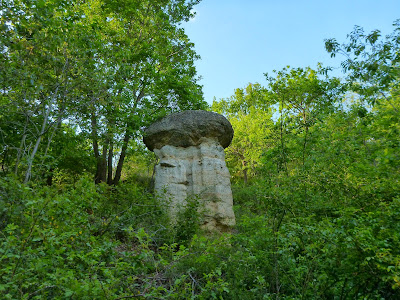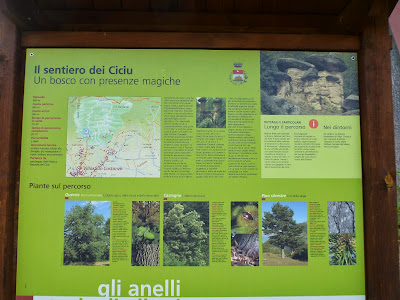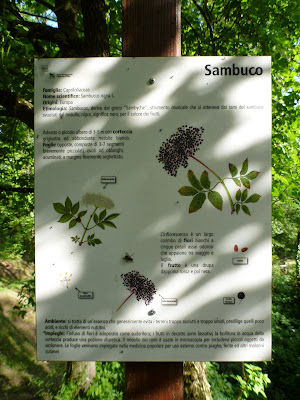Left: Ciciu at Villar San Con Costanzo; Right: Detail of Harp at Museo dell’Arpa, Piasco
On a pleasant day spring day in May 2013, we visited the Museo dell’Arpa Victor Salvi in Piasco and the Natural Ciciu del Villar Reserve, near Dronero, both in the Province of Cuneo (both are north of the town of Cuneo). We were spending an afternoon and evening with one of our Italian families.
Museo dell’Arpa
Left: Map (Google) Showing Location of the Harp Museum in Piasco; Right: Entry to Harp Museum
The Museo dell’Arpa (Harp Museum) is a small museum attached to (really, sitting on top of) the Salvi harp factory. It’s a bit tricky to find (see map included in this post). The museum experience is a 20 minute film followed by a look at the items on display, which change over time. Only a fraction of the 100+ antique harps in the collection are on display at any given time. The museum brochure claims this to be un museo unico al mondo because it is the only museum dedicated to the harp. You will see harps made by Sébastien Érard (1752 – 1831), who invented the double-movement that revolutionized how the harp is played. And, you’ll see Salvi harps, of course.
The museum as a destination is going to please harp fans and classical musicians. Others, may find the location and the chance to chat in Italian more interesting. (We wouldn’t string you along.) Some considerations:
- The visit will be short. We took less than an hour.
- We didn’t get to see the workshops (building or restoring of harps), which is what we expected, so it was a bit disappointing on this account.
- The museum itself was hot, not just warm, but very hot. It was only May and we were baking up there, so be warned.
Who is Victor Salvi? His family came from Viggiano, a town in Basilicata, renowned for the construction of harps. (His father came from Venezia.) Salvi’s family immigrated to America, fleeing World War I and Salvi was born in Chicago. His sister and brother were harpists and his father was an instrument maker (un liutaio). Victor became the harpist for the New York Philharmonic and the NBC Symphony Orchestra directed by Arturo Toscanini. In 1954, in New York, Salvi created his first harp. He returned to Italy a few years later to continue making harps near Genoa. Later, in the 1970s, he transferred his workshop to Piasco, by various accounts to enlarge it and take advantage of the local woodworking tradition of the Varaita Valley.
Museo dell’Arpa Brochure Pages


Left: Entry to Museo dell’Arpa, Spiral Staircase (There is an elevator.); Right: Reception area in the Museum.
Ciciu
La Riserva naturale dei Ciciu del Villar (official site) is a park that contains the "ciciu del Villar" translated as "puppets of Villar". The puppets are large stone formations that look like large mushrooms. These stone mushrooms with a tan stalk (composed of earth) and a dark cap (gneiss) or as the Italian Wikipedia article says “i massi erratici sorretti da colonne di terreno: dei camini delle fate” – boulders supported by columns of dirt: fairy chimneys. The mushrooms or puppets were formed by a three step process (taken from a sign in the park):
Step 1: “Le colonne di erosione di Villar San Costanzo ebbero origine al termine dell’era glaciale, quando il torrente Fanssimagna (un affluente del torrente Maira) con lo scioglimento dei ghiacciai and`o ad erodere le pendici del monte San Bernardo, portando a valle una enorme masse di detriti.”
The ciciu of Villar San Costanzo During were formed at the end of the last ice age (approximately 12,000 years ago), when the Fanssimagna river (a tributary of the Maira) overflowed with glacial melt, eroding the slopes of Mount St. Bernardo and carrying a huge mass of debris to the valley.
Step 2: “Si verificarono inoltre delle forte scosse sismiche che staccarono grandi massi scuri dal Monte San Bernardo e li fecero rotolare a valle, proprio sulla grande massa di detriti prima trasportati dal torrente.”
Later, strong earthquakes caused large boulders of darker stone (gneiss) to break away from Mount St. Bernardo and roll down to the valley, covering the debris transported by the glacial melt.Step 3: “Successivamente il Fanssimagna, continuando inesorabile il suo lavoro, andò a ricoprire I massi che si erano staccati dal Monte San Bernardo. Nei secoli successivi imponenti movimenti tettonici provocarono l’innalzamento della pianura cuneese obbligando I torrenti a scavarsi un nuovo letto. Il torrente Fanssimagna riportò così all luce quei massi che precedentemente aveva ricoperto; ma mentre il terreno no riparato e compattato dalle grandi pietre veniva trasportato velocemente a valle, quelle sotto I massi rimase sul posto formando orginali colonne di terra rossa con un masso scuro e rotondeggiante come ‘cappello’.”
The Fanssimagna continued to carry debris and cover the dark rock, which had broken off from Mount St. Bernardo. In the following centuries, massive tectonic events caused the Cuneo plain to rise, forcing rivers to find new paths. The Fanssimagna, in finding a new path, uncovered the previously covered dark stone. And the earth not compacted and protected by the darker, larger stone was transported away, while the earth under the stones remained in place and formed columns of red clay with a dark boulder as a ‘hat’.
We arrived at the reserve in the late afternoon, took took a short hike on the path winding through the ciciu, and then finished out the evening with a barbeque – picnic in one of the park’s common areas.
The Parco naturale del Marguareis site contains some good information on the reserve, including some cartoons on protecting the ciciu and information on how they are formed [1]. This website also includes information about two other sites we have been to: the Benevagienna site (post: Augusta Bagiennorum) and Gotto di Bossea (post: Grotta di Bossea).
Left: Map of the Riserva; Center: Ciciu Story – Cartoon [1]; Right: Il fenomeno scentifico [1].


Left: Looking Southeast from La Riserva Naturale dei Ciciu del Villar; Right: A Single Ciciu
Left: Ciciu Stalk (made of compacted soil), and Cap (made of gneiss); Right: A Grouping of Ciciu
Informational Signs from the Riserva Naturale Ciciu del Villar
Left: Example of Sign about Trees in the Reserve: Sambuco, Elderberry; Right: Elderberry














No comments:
Post a Comment
All comments are moderated. If your comment doesn't appear right away, it was likely accepted. Check back in a day if you asked a question.